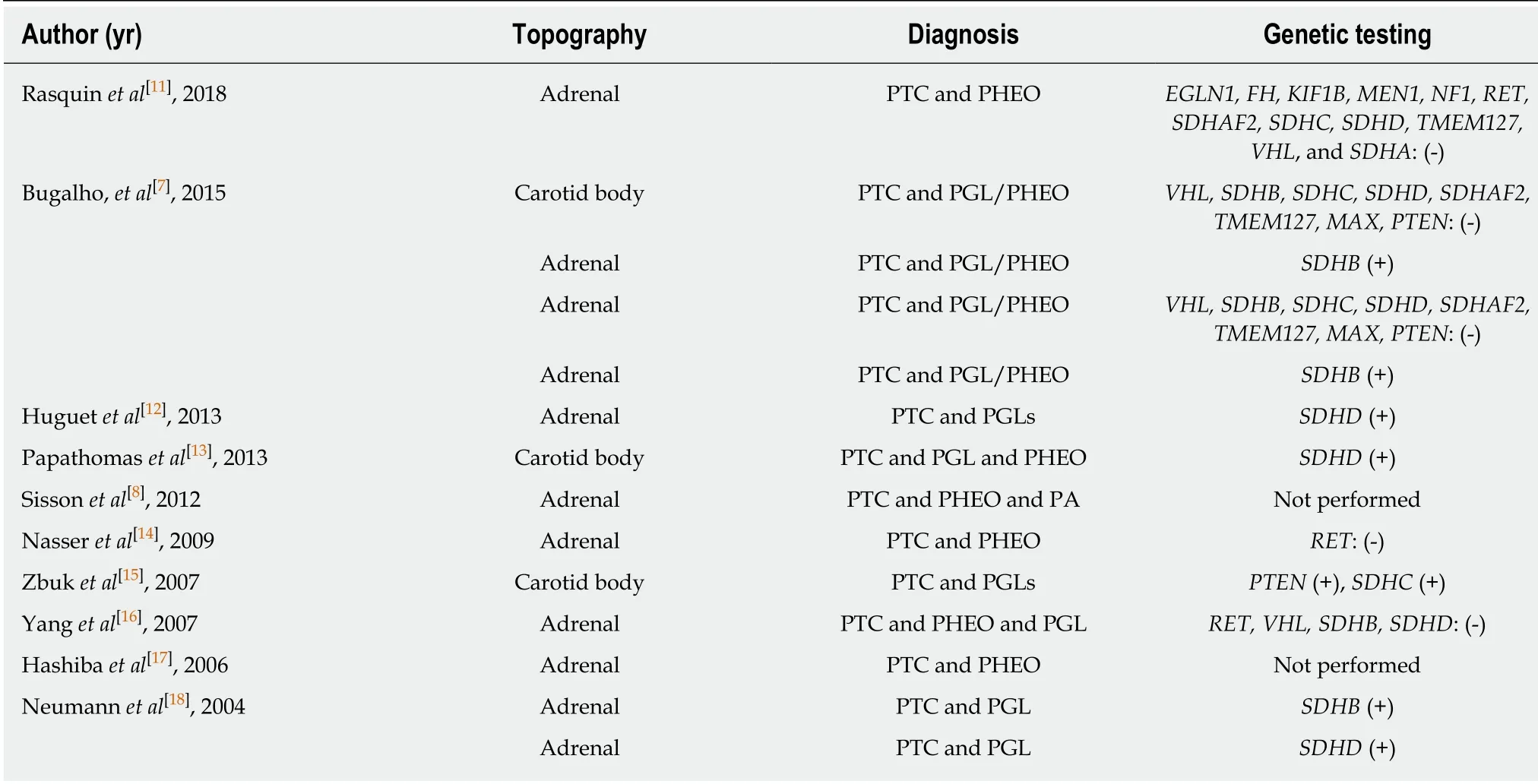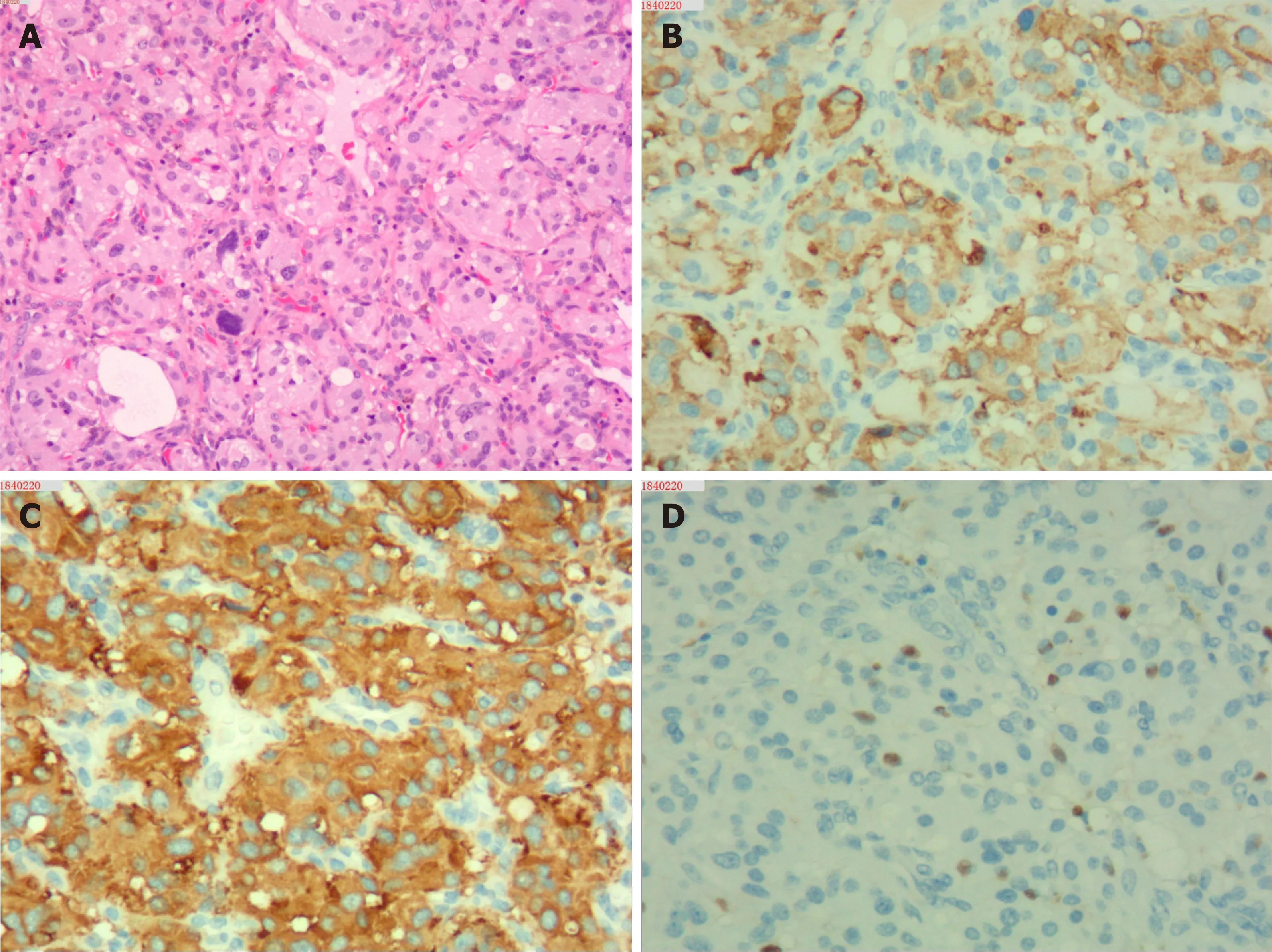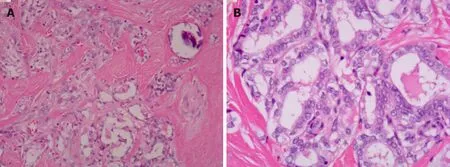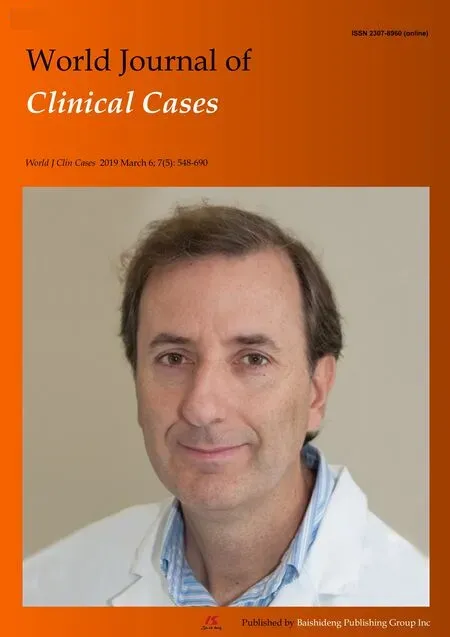Concomitant paraganglioma and thyroid carcinoma:A case report
Bo Lin,Hong-Yu Yang,Hui-Jun Yang,Shi-Yue Shen
Abstract
Key words: Paraganglioma; Thyroid carcinoma; Multiple endocrine tumors; Case report
INTRODUCTION
Carotid body tumors represent approximately 65% of head and neck paragangliomas,followed by glomus jugulare and glomus tympanicum tumors[1].
A paraganglioma can partly or wholly be associated with other tumors such as kidney cancer,parathyroid adenoma,thyroid carcinoma,gastrointestinal stromal tumors,and astrocytoma[2].
Coexistence of paraganglioma/pheochromocytoma (PHEO) and medullary thyroid carcinoma (MTC) is strongly suggestive of multiple endocrine neoplasia (MEN),in such cases,succinate dehydrogenase subunit B (SDHB) and subunit D (SDHD)mutation was frequently reported as positive[3,4].
Herein,we report a patient with a combination of paraganglioma and papillary thyroid carcinoma.The tumors were surgically removed with minimal blood loss and temporary neurological loss.An analysis of RET porto-oncogene mutation yielded negative results.To our best knowledge,this unusual association of the two tumors represents a novel entity.
In addition,we summarize the clinical manifestations and the imaging and pathological features of the tumors.
CASE PRESENTATION
Chief complaints
A 51-year-old man was admitted to our department with a year-long history of swelling on the right-sided neck.
History of present illness
He also had a history of hypertension for three years,but without any medical treatment,and his blood pressure and heart rate at presentation were 150/94 mmHg and 83 beats/min,respectively.
History of past illness
He was diagnosed with diabetes three years ago and took metformin to control the blood sugar levels.He did not describe other constitutional symptoms such as episodes of diaphoresis,weight loss,or palpitations.
Personal and family history
The family history was unremarkable.
Physical examination upon admission
Obvious pulsation could be found on the right-sided neck masses.The masses were firm in texture and are not accompanied by pain.Cranial nerve examinations were intact,and the otolaryngology examination was negative.
Laboratory examinations
Concentrations of serum calcium,phosphorus,and parathormone were normal.Besides,radiotracer-labeled metaiodobenzyl-guanidine scintigraphy and serum and urine catecholamine and metanephrine levels were negative.Laboratory tests combined with abdominal computed tomography (CT) excluded the diagnosis of a PHEO.Serum thyroid stimulating hormone and free thyroxine,calcitonin,and carcinoembryonic antigen were within normal limits.
Imaging examinations
Enhanced CT revealed two irregular solid nodules,consisting of 3.5 × 3.6 × 4.0 cm soft tissue density located in the right carotid artery bifurcation with heterogeneous reinforcement.The mass surrounded both the internal and external carotid arteries;however,a clear boundary between the tumor and the artery could be found.At the same time,a low-density nodule of the thyroid isthmus measuring about 11 mm in diameter with a spot-like dense shadow could be seen.Carotid angiography demonstrated a blood-rich tumor at the carotid bifurcation that surrounded the internal and external carotid arteries.Figure 1 shows the paraganglioma and thyroid cancer,respectively (Figure 1 A and B),which were displayed simultaneously in the same section (Figure 1C).
Ultrasound showed a hypoechoic mass near the isthmus measuring about 18 × 15 ×12 mm in size.The boundary of the mass was unclear and calcification could be seen in the internal echo.An ultrasound-guided fine needle aspiration biopsy (FNAB) of the thyroid nodule revealed papillary thyroid carcinoma.
FINAL DIAGNOSIS
Based on the clinical characteristics and radiographic results,a combination of carotid body tumor and thyroid papillary carcinoma was raised.
TREATMENT
The patient underwent thyroidectomy,neck dissection,and surgery for removal of the right-sided lesion.
During surgery,the dissection of the encapsulated mass from the carotid bifurcation was performed.The internal carotid artery and external carotid artery remained intact.Total thyroidectomy removed a nodular left lobe and normalappearing right lobe,isthmus,and pyramidal lobe,with right-side selective neck dissection (levels II-V).
Total thyroidectomy removed a nodular left lobe and normal-appearing right lobe,isthmus,and pyramidal lobe,with right-side selective neck dissection (levels II-V).
Upon microscopic analysis,the tumor at the carotid artery bifurcation appeared to have rich blood supply,formed by epithelial cells lying in a trabecular pattern and arranged in a “Zellballen” structure (Figure 2).In the thyroid tumor,the cells lining the papillary structures showed nuclear grooves and nuclear clearing,which are characteristic nuclear features of papillary thyroid carcinoma (Figure 3).The final histopathologic diagnosis was paraganglioma and thyroid papillary carcinoma.Immunohistochemical staining revealed positive staining for chromogranin and synaptophysin; the sustentacular cells stained positively for S100 protein.
Analysis of theRETproto-oncogene mutation,von Hippel Lindau (VHL) mutation,SDHBmutation,andSDHDmutation showed negative results.
OUTCOME AND FOLLOW-UP
Nifedipine was administered after the operation as the patient continued to be hypertensive.The patient experienced two weeks of hoarseness after operation without other neurological symptoms.He was treated with131I after surgery and so far disease-free.The patient is still being followed.
DISCUSSION
Paragangliomas are rare neuroendocrine neoplasms that originate from chromaffin cells of the adrenal medulla.CBT is a form of head and neck paraganglioma arising at the carotid bifurcation.
MEN is characterized by thyroid,adrenal medulla,and parathyroid neuroendocrine cell proliferation or tumor,and the clinical manifestations are MTC,PHEO,and primary parathyroid primary hyperparathyroidism[5,6].A few cases were reported to exhibit combinations of PHEO,abdominal paraganglioma,and papillary thyroid carcinoma[7,8].However,the coexistence of head and neck paraganglioma and papillary thyroid carcinoma was extremely rare and only reported in three cases(Table 1).
Clinically,thyroid masses,as well as symptoms of increased secretion of catecholamines such as paroxysmal hypertension,headache,palpitations,and sweating are most common.The high blood pressure in our patient raised the suspicion of MEN,but the normal serum and urine catecholamine and metanephrine levels and abdominal ultrasound eliminate PHEO.

Figure 1 Preoperative images of the tumor.
When an endocrine gland tumor is discovered,the possibility of MEN should be considered and screened for.Serum calcitonin is a special indicator for the diagnosis of MTC,which can be more than 1000 pg/mL.CT,digital subtraction angiography(DSA),and MRI are helpful to locate the paraganglioma,while ultrasonography and FNAB are more reliable for detection of thyroid tumors.
CT angiography (CTA) is required for preoperative diagnosis and treatment strategies.It can significantly improve the recognition of tumors and identify the anatomical relationship between the tumor and important blood vessels.Correct diagnosis of CBT by careful clinical physical examination is not difficult,but the advantage of CTA is that it can help identify the “feeding artery” of the tumor and provide critical information for surgery.
Moreover,it was through CT that an asymptomatic thyroid tumor was found,which could further confirm the diagnosis.
RET was identified as aMEN-2susceptibility gene in 1993,and the gene carrier’s penetrance rate is almost 100%[9].In head and neck paraganglioma,a mutation of the D subunit of theSDHgene is identified in 50%-94% of cases,while a mutation of the B subunit is identified in 10%-20% of cases[10].Neumannet al[18]suggested that whether thyroid malignancies are also components of SDHB or SDHD related disease awaits further confirmation.The genetic testing in the reported cases is reviewed in Table 1.The results of these studies indicate that the PTC-PGL/PHEO seems to have a heterogeneous genetic background.However,the genetic testing of our cases is not the same as previous studies.Whether this association is coincidental or has a genetic underlying relationship remains identification.
Onset involves multiple organs,and the treatment emphasizes multidisciplinary cooperation.Different lesions are mainly treated by related specialists,but it is necessary to avoid isolated treatment of a single subject.Removal of the paraganglioma and papillary cancer was the optimal treatment in this case,but it was necessary to exclude PHEO,as otherwise,other procedures could have induced hypertensive crisis.However,paraganglioma resection at the carotid bifurcation remains a challenge for surgeons because of its rich blood supply.
To our best understanding and knowledge,no known syndrome or conceivable interrelationships among the tumors explained this combination presentation.This case highlights that the presence of concomitant paraganglioma and thyroid papillary carcinoma could be either coincidental or a result of an underlying unknown mutation.
ACKNOWLEDGEMENT
The authors thank Ms.YJ Huang for her support of the study.

Table 1 Literature review

Figure 2 Microscopic features of the paraganglioma.

Figure 3 Microscopic features of the papillary thyroid carcinoma.
 World Journal of Clinical Cases2019年5期
World Journal of Clinical Cases2019年5期
- World Journal of Clinical Cases的其它文章
- Melanotic Xp11-associated tumor of the sigmoid colon:A case report
- Intrauterine cystic adenomyosis:Report of two cases
- Use of tunnel endoscopy for diagnosis of obscure submucosal esophageal adenocarcinoma:A case report and review of the literature with emphasis on causes of esophageal stenosis
- Rare empty sella syndrome found after postoperative hypotension and respiratory failure:A case report
- Application of computer-assisted navigation in treating congenital maxillomandibular syngnathia:A case report
- Perioperative topical ascorbic acid for the prevention of phacoemulsification-related corneal endothelial damage:Two case reports and review of literature
